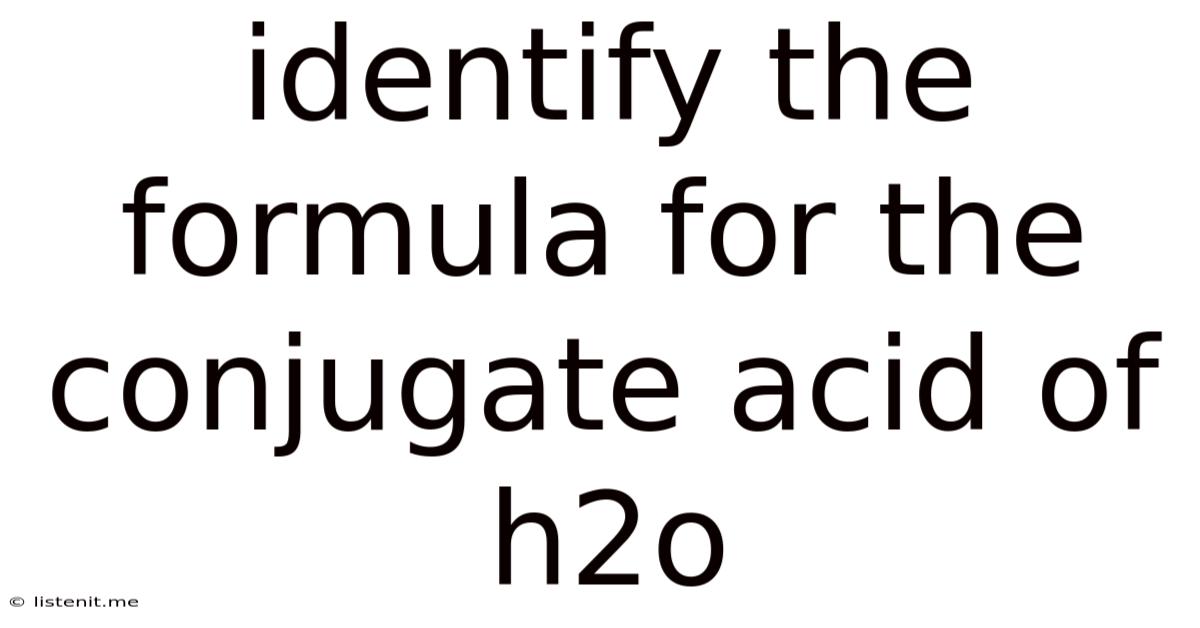Identify The Formula For The Conjugate Acid Of H2o
listenit
May 12, 2025 · 5 min read

Table of Contents
Identifying the Formula for the Conjugate Acid of H₂O: A Deep Dive into Acid-Base Chemistry
Understanding conjugate acid-base pairs is fundamental to grasping acid-base chemistry. This article will thoroughly explore the concept, focusing specifically on identifying the formula for the conjugate acid of water (H₂O). We'll delve into the definitions, explore the Brønsted-Lowry theory, and work through examples to solidify your understanding. By the end, you'll not only know the formula but also possess a deeper comprehension of the principles involved.
What is a Conjugate Acid?
According to the Brønsted-Lowry theory, an acid is a substance that donates a proton (H⁺), while a base is a substance that accepts a proton. A conjugate acid-base pair is formed when an acid donates a proton, resulting in its conjugate base, and a base accepts a proton, forming its conjugate acid. The conjugate acid always has one more proton (H⁺) than its conjugate base.
Key takeaway: The conjugate acid is formed when a base accepts a proton. This means it will have one more hydrogen atom (and a corresponding positive charge) than the original base.
The Brønsted-Lowry Theory and Conjugate Pairs
The Brønsted-Lowry theory provides a comprehensive framework for understanding acid-base reactions. It's crucial for understanding conjugate acid-base pairs. Let's illustrate this with an example:
Consider the reaction between water (H₂O) and hydrochloric acid (HCl):
HCl(aq) + H₂O(l) ⇌ H₃O⁺(aq) + Cl⁻(aq)
In this reaction:
- HCl acts as the acid, donating a proton (H⁺) to water.
- H₂O acts as the base, accepting a proton from HCl.
- H₃O⁺ (hydronium ion) is the conjugate acid of H₂O. It's formed when H₂O accepts a proton.
- Cl⁻ (chloride ion) is the conjugate base of HCl. It's formed when HCl donates a proton.
Identifying the Conjugate Acid of H₂O
Now, let's focus specifically on water (H₂O). To find its conjugate acid, we need to determine what happens when water acts as a base and accepts a proton. When a water molecule accepts a proton (H⁺), it becomes:
H₂O + H⁺ → H₃O⁺
Therefore, the formula for the conjugate acid of H₂O is H₃O⁺, the hydronium ion.
Understanding the Role of Water in Acid-Base Reactions
Water is an amphoteric substance, meaning it can act as both an acid and a base. This dual nature allows it to participate in various acid-base reactions:
-
As an acid: Water can donate a proton, as seen in the reaction with ammonia (NH₃): H₂O(l) + NH₃(aq) ⇌ NH₄⁺(aq) + OH⁻(aq) In this case, OH⁻ is the conjugate base of water.
-
As a base: Water can accept a proton, as seen in the reaction with HCl (mentioned earlier): HCl(aq) + H₂O(l) ⇌ H₃O⁺(aq) + Cl⁻(aq) Here, H₃O⁺ is the conjugate acid of water.
Examples of Conjugate Acid-Base Pairs
Let's examine more examples to further solidify the concept of conjugate acid-base pairs:
| Base | Conjugate Acid |
|---|---|
| NH₃ (Ammonia) | NH₄⁺ (Ammonium) |
| OH⁻ (Hydroxide) | H₂O (Water) |
| H₂O (Water) | H₃O⁺ (Hydronium) |
| HCO₃⁻ (Bicarbonate) | H₂CO₃ (Carbonic acid) |
| CH₃COO⁻ (Acetate) | CH₃COOH (Acetic acid) |
In each case, the conjugate acid has one more proton than the corresponding base.
Practical Applications and Importance
Understanding conjugate acids and bases is crucial in numerous scientific fields and practical applications:
- Chemistry: It's essential for predicting the outcome of acid-base reactions, determining pH, and understanding buffer solutions.
- Biology: It plays a vital role in understanding biological processes, such as enzyme activity and protein structure, which are highly sensitive to pH changes.
- Environmental Science: Acid rain and its impact on ecosystems are directly related to acid-base chemistry and the concept of conjugate acid-base pairs.
- Medicine: Many medications and biological processes involve acid-base reactions, making this knowledge essential in pharmaceutical development and treatment strategies.
Advanced Concepts and Further Exploration
While this article focuses on the basic principles, several advanced concepts build upon this foundation:
- Acid dissociation constant (Ka): This constant quantifies the strength of an acid and is related to the equilibrium between an acid and its conjugate base.
- Base dissociation constant (Kb): This constant quantifies the strength of a base and is related to the equilibrium between a base and its conjugate acid.
- pKa and pKb: These are logarithmic representations of Ka and Kb, making them easier to use and compare.
- Buffer solutions: These solutions resist changes in pH and are made by combining a weak acid and its conjugate base or a weak base and its conjugate acid.
Understanding these advanced concepts allows for a more complete and nuanced understanding of acid-base chemistry.
Conclusion
The formula for the conjugate acid of H₂O is H₃O⁺, the hydronium ion. This fundamental concept, grounded in the Brønsted-Lowry theory, is crucial for comprehending acid-base reactions and their far-reaching applications in various scientific disciplines. By grasping the principles discussed here, you gain a solid foundation for further exploration of acid-base chemistry and its vital role in the world around us. Remember to practice identifying conjugate acid-base pairs to strengthen your understanding and prepare for more complex topics in chemistry. This article has provided a robust foundation; continue your learning journey by exploring additional resources and engaging in problem-solving exercises. The more you practice, the more confident you'll become in your understanding of this essential aspect of chemistry.
Latest Posts
Related Post
Thank you for visiting our website which covers about Identify The Formula For The Conjugate Acid Of H2o . We hope the information provided has been useful to you. Feel free to contact us if you have any questions or need further assistance. See you next time and don't miss to bookmark.